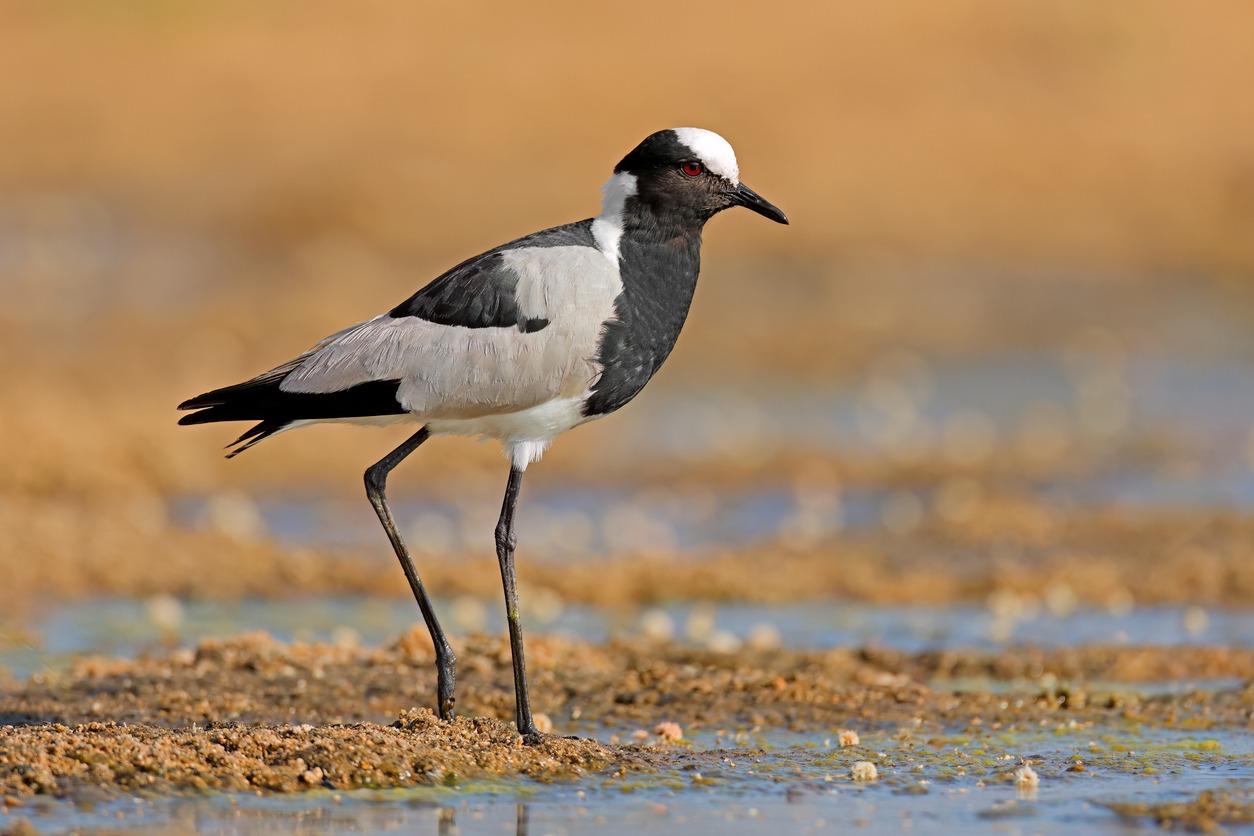The Blacksmith Plover, also known as the Bontkiewiet, Blacksmith Lapwing, and Vanellus armatus, is a small bird that is commonly found in the southeast region of the African continent. Its name was derived from its repeated alarm call that sounds “tink, tink, tink,” which refers to a blacksmith’s way of hammer striking a metal piece. It is one of the five lapwing birds (two of which are seen in Africa, one in Asia, and two in neotropical) with red eyes and distinct pied plumage.
This bird species was first described in 1822 by English explorer, traveler, artist, author, and naturalist William John Burchell.
Due to its extensive range and occurrence across the African continent, the International Union for Conservation of Nature (IUCN) Red List categorized this bird species as Last Concern.
Its seven levels of scientific classification are as follows:
Kingdom: Animalia
Phylum: Chordata
Class: Aves
Order: Charadriiformes
Family: Charadriidae
Genus: Vanellus
Species: V. armatus
The physical characteristics of a Blacksmith Plover
An adult Blacksmith Plover generally has bold gray, black, and white plumage. These colors appear to be possible warning colors to ward off predators. It has long, slender brown legs. It has a sharp dark protrusion which it uses to defend their chicks from predators and potential threats. It has a white crown, black face, black beak, and black breast. Juveniles tend to have brownish plumage.
An adult grows an average of 31 cm in height, and weighs at an average of 170 g. A female Blacksmith Plover is usually larger than a male, but generally, they share the same physical attributes.
The distribution and habitat of Blacksmith Plovers
This bird species appears in Africa’s south and eastern regions, particularly in Kenya, central Tanzania, Angola, Botswana, Zimbabwe, Mozambique, the Democratic Republic of Congo, Lesotho, Zambia, South Africa, and southwestern Africa. Blacksmith Plovers frequent wetlands of any size and avoid higher-rainfall grasslands and various mountains. They leave habitats with high rainfall occurrence and may return years later during the dry season.
The Blacksmith Plovers take refuge near water bodies such as rivers, lakes, streams, swaps, estuaries, lagoons, marshy grasslands, and floodplains.
During the 20th century, Blacksmith Plovers expanded their range throughout Africa when dams were being constructed, and intensive farming was being put to practice. This bird species are semi-migratory. However, they do not engage in regular, large-scale migrations.
The behavior of a Blacksmith Plover
This bird species are considered diurnal birds, meaning Blacksmith Plovers spend the day looking around for food. These birds usually walk on the ground and feed there as well. But sometimes, they catch insects through biting on the wing.
Blacksmith Plovers hunt in shallow waters as well. These birds shake their legs underwater to attract prey, so they appear on the surface. They congregate in large flocks or in pairs. They are also considered as noisy birds because of their “tink tink tink” calls. Due to this distinctive, loud calling, the Blacksmith Plover’s calls act as “little alarm system” to their species and nearby inhabitants of possible threats and intruders.
These birds are very brave for their size. Once someone attempts to intrude their territories, Blacksmith Plovers would not hesitate to attack it while crying a very loud call. It points its sharp bill towards the intruder and flaps its wings continuously. This defense display effectively deters predators and intruders.
This bird species build monogamous relationships and form bonds that last a lifetime. They usually breed during spring. Blacksmith Plovers are solitary nesters, but during the breeding season, they become territorial. A pair will often build a nest under or behind the bush, on bare ground, or on short grass just near a water source. A female Blacksmith Plover will lay 1-4 eggs. Both parents will take responsibility for incubating the eggs for 26 to 33 days. Once hatched, the chicks will remain dependent on their parents during the first week. They will fledge 40 days after hatching. After a month, they will become independent. They will fly away from their parents and usually would not return to their natal areas afterward.
The diet of Blacksmith Plovers
This bird species feeds on different organisms such as ants, beetles, worms, crustaceans, insects, larvae, mollusks, and butterflies.
Sources:
http://animalia.bio/blacksmith-lapwing
https://www.beautyofbirds.com/blacksmithlapwings.html
https://ebird.org/species/blaplo1
https://en.wikipedia.org/wiki/Blacksmith_lapwing
BOTSWANA BIRDS | SOUTH AFRICA BIRDS
NAMIBIA BIRDS | ZAMBIA BIRDS | ZIMBABWE BIRDS

